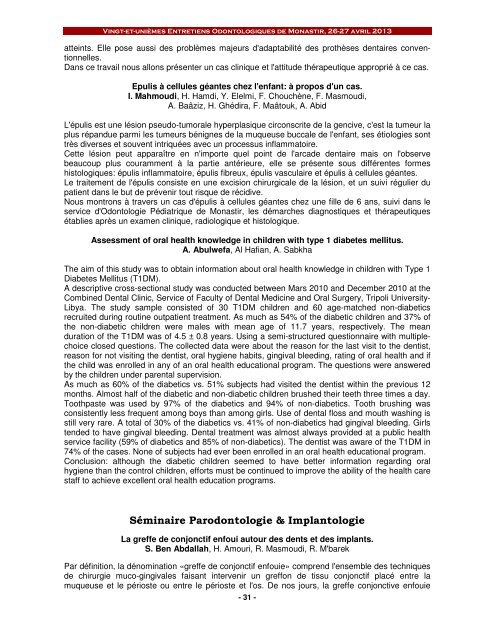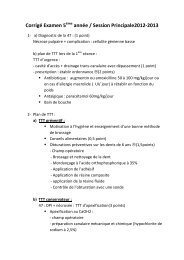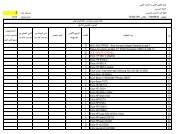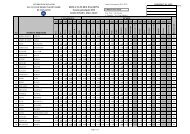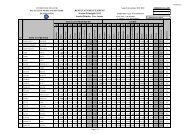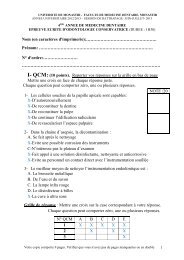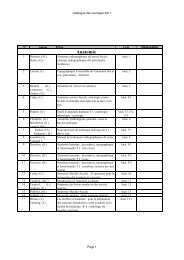Programme - Faculté de Medecine Dentaire de Monastir
Programme - Faculté de Medecine Dentaire de Monastir
Programme - Faculté de Medecine Dentaire de Monastir
Create successful ePaper yourself
Turn your PDF publications into a flip-book with our unique Google optimized e-Paper software.
Vingt-et-unièmes Entretiens Odontologiques <strong>de</strong> <strong>Monastir</strong>, 26-27 avril 2013<br />
atteints. Elle pose aussi <strong>de</strong>s problèmes majeurs d'adaptabilité <strong>de</strong>s prothèses <strong>de</strong>ntaires conventionnelles.<br />
Dans ce travail nous allons présenter un cas clinique et l'attitu<strong>de</strong> thérapeutique approprié à ce cas.<br />
Epulis à cellules géantes chez l'enfant: à propos d'un cas.<br />
I. Mahmoudi, H. Hamdi, Y. Elelmi, F. Chouchène, F. Masmoudi,<br />
A. Baâziz, H. Ghédira, F. Maâtouk, A. Abid<br />
L'épulis est une lésion pseudo-tumorale hyperplasique circonscrite <strong>de</strong> la gencive, c'est la tumeur la<br />
plus répandue parmi les tumeurs bénignes <strong>de</strong> la muqueuse buccale <strong>de</strong> l'enfant, ses étiologies sont<br />
très diverses et souvent intriquées avec un processus inflammatoire.<br />
Cette lésion peut apparaître en n'importe quel point <strong>de</strong> l'arca<strong>de</strong> <strong>de</strong>ntaire mais on l'observe<br />
beaucoup plus couramment à la partie antérieure, elle se présente sous différentes formes<br />
histologiques: épulis inflammatoire, épulis fibreux, épulis vasculaire et épulis à cellules géantes.<br />
Le traitement <strong>de</strong> l'épulis consiste en une excision chirurgicale <strong>de</strong> la lésion, et un suivi régulier du<br />
patient dans le but <strong>de</strong> prévenir tout risque <strong>de</strong> récidive.<br />
Nous montrons à travers un cas d'épulis à cellules géantes chez une fille <strong>de</strong> 6 ans, suivi dans le<br />
service d'Odontologie Pédiatrique <strong>de</strong> <strong>Monastir</strong>, les démarches diagnostiques et thérapeutiques<br />
établies après un examen clinique, radiologique et histologique.<br />
Assessment of oral health knowledge in children with type 1 diabetes mellitus.<br />
A. Abulwefa, Al Hafian, A. Sabkha<br />
The aim of this study was to obtain information about oral health knowledge in children with Type 1<br />
Diabetes Mellitus (T1DM).<br />
A <strong>de</strong>scriptive cross-sectional study was conducted between Mars 2010 and December 2010 at the<br />
Combined Dental Clinic, Service of Faculty of Dental Medicine and Oral Surgery, Tripoli University-<br />
Libya. The study sample consisted of 30 T1DM children and 60 age-matched non-diabetics<br />
recruited during routine outpatient treatment. As much as 54% of the diabetic children and 37% of<br />
the non-diabetic children were males with mean age of 11.7 years, respectively. The mean<br />
duration of the T1DM was of 4.5 ± 0.8 years. Using a semi-structured questionnaire with multiplechoice<br />
closed questions. The collected data were about the reason for the last visit to the <strong>de</strong>ntist,<br />
reason for not visiting the <strong>de</strong>ntist, oral hygiene habits, gingival bleeding, rating of oral health and if<br />
the child was enrolled in any of an oral health educational program. The questions were answered<br />
by the children un<strong>de</strong>r parental supervision.<br />
As much as 60% of the diabetics vs. 51% subjects had visited the <strong>de</strong>ntist within the previous 12<br />
months. Almost half of the diabetic and non-diabetic children brushed their teeth three times a day.<br />
Toothpaste was used by 97% of the diabetics and 94% of non-diabetics. Tooth brushing was<br />
consistently less frequent among boys than among girls. Use of <strong>de</strong>ntal floss and mouth washing is<br />
still very rare. A total of 30% of the diabetics vs. 41% of non-diabetics had gingival bleeding. Girls<br />
ten<strong>de</strong>d to have gingival bleeding. Dental treatment was almost always provi<strong>de</strong>d at a public health<br />
service facility (59% of diabetics and 85% of non-diabetics). The <strong>de</strong>ntist was aware of the T1DM in<br />
74% of the cases. None of subjects had ever been enrolled in an oral health educational program.<br />
Conclusion: although the diabetic children seemed to have better information regarding oral<br />
hygiene than the control children, efforts must be continued to improve the ability of the health care<br />
staff to achieve excellent oral health education programs.<br />
Séminaire Parodontologie & Implantologie<br />
La greffe <strong>de</strong> conjonctif enfoui autour <strong>de</strong>s <strong>de</strong>nts et <strong>de</strong>s implants.<br />
S. Ben Abdallah, H. Amouri, R. Masmoudi, R. M'barek<br />
Par définition, la dénomination «greffe <strong>de</strong> conjonctif enfouie» comprend l'ensemble <strong>de</strong>s techniques<br />
<strong>de</strong> chirurgie muco-gingivales faisant intervenir un greffon <strong>de</strong> tissu conjonctif placé entre la<br />
muqueuse et le périoste ou entre le périoste et l'os. De nos jours, la greffe conjonctive enfouie<br />
- 31 -


